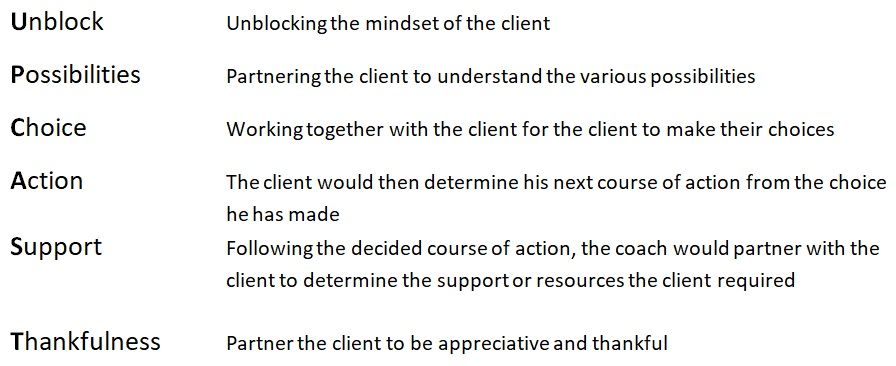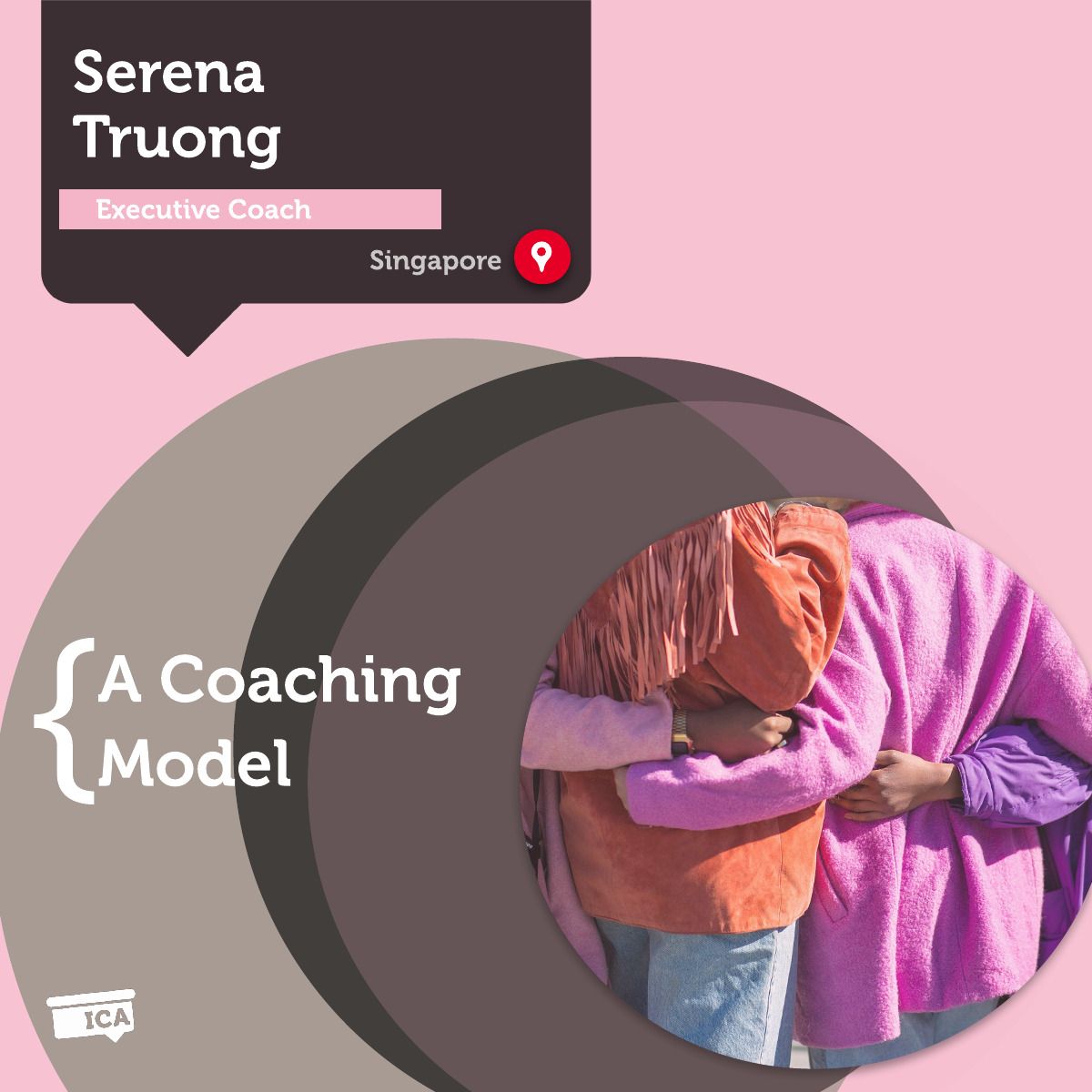A Coaching Model By Serena Truong, Executive Coach, SINGAPORE
UPCAST Coaching Model
The International Coaching Community defines coaching as a means to unlock a person’s potential to maximize their performance. Coaching helps a person to learn rather than by teaching them. Coaching is essentially to help a person to change in the way that the person wishes to and helps them to go in the direction they want to go. Coaching supports a person at every level to be who they want to be and creates awareness, empowers choice and leads to change.
The role of a coach is like an X-ray mirror and a partner to the client.
My analogy of an X-ray mirror is because a coach helps the client to reflect on themselves and to see beneath their initial thoughts, beliefs and intent to discover the solutions within themselves. The journey of self-discovery ultimately belongs to the client and the role of a coach is to partner the client through this journey without judgement – supporting and partnering the client through the process.
A coach is a partner to the client – supporting them through their journey to unlock their potential. This journey would be led by the client. The coach needs to remember that the foundation of all these activities to self-discovery and progress is the will and desire of the client
My coaching model goes by the acronym UPCAST. A client who is struggling to decide how to proceed or what his options are maybe downcast and lost. With the UPCAST coaching model, the client would transform his views from a downcast position to one which is upcast.
This coaching model outlines the various exploration areas on which a coach can embark with his client.
Coaching Model Upcast Is the Acronym For:

Unblock
The first step of my coaching model is when a coach partners his client and helps his client move from a state of being blocked or stuck to one of being Unblocked.
To help the client move forward with his goals, a coach needs to help the client to understand the client’s underlying beliefs and ideas. There are several reasons why a person may feel blocked or stuck in the situation they are in. Some common reasons could be decision fatigue, encountering Imposter Syndrome and having limiting beliefs. A client who is in a blocked situation would generally articulate their concerns by saying something similar to ‘’I would like to … but ….”.
In this phase of exploration, you would want to partner with the client to support them in discovering the underlying cause hindering them from achieving their goals. There are various reasons attributed to the client being unable to move forward. Examples include fear, limiting beliefs, doubt etc. In such instances, reframing the perspectives of the clients would help them move forward and unlock their potential.
Questions that you can ask at this stage could include:
- How does that belief support you in achieving your goals
- What would your best self say to you?
- What will looking at this differently give you?
- What is keeping you from ….
- What is getting in the way of you…
- What does an ideal situation look like? What is keeping you from this ideal situation?
- What would it take for you to move forward?
Through the series of questions, the client may discover that their own limiting beliefs are preventing them from moving forward and would change their perspective on the situation.
Possibilities
Possibilities are the next phase of exploration with the client. After the coach has worked with their clients to reframe their perspective, the coach would partner with the clients in looking at the various possibilities. A client discovering various possibilities to their situation would likely feel empowered by the situation. This would enable the client more confidence to determine the way forward and take the next steps towards their goals.
Questions you can explore with your clients to help them to discover their possibilities include:
- What other options do you have?
- What could you do to…(the desire of the client)
- What does looking at this from a different perspective bring for you?
- Imagine you have successfully achieved where you aspire to be. What would your future self advise you?
- What would your best self say to you?
A client may also request for the coach to partner with them in determining which of the possibilities and choices are best for their next steps. This brings us to the next phase of this model.
Choice
The choice is a phase in the coaching process when the client realizes that there are various options and possibilities before him. In this phase of the coaching journey, the coach partners with the client to walk through their various possibilities, looking at key considerations and motivations. The coach partners with the client to gain better clarity and the client then makes a conscious decision on how to proceed forward.
Common questions asked during the Choice phase includes:
- What are your key considerations in making this decision?
- What do you wish to achieve?
- How does making this decision serve you in achieving your goal?
- What’s coming up for you as you consider this approach?
Action
After a client has determined which choice they want to take, the coach then partners with the client to plan out the action plans. The coach partners with the client to walk through their key considerations and their chartered next path of action. There could be several action plans stemming from the Choice made by the client and the coach walks through these with the client methodically and thoughtfully. The coach would also ask the client supporting questions so that the client is held accountable for implementing the actions the client has planned out.
Examples of questions that the coach may ask a client in determining the action plans are:
- Having decided on your choice, what would you like to do next?
- What would be the next step for you?
- What would help you put that into action?
- How would you apply this decision?
- What will you do to hold yourself accountable?
- What will you do to make this commitment happen?
Support
Some Clients may need support to implement their action plans. This support can come in the form of a process, a person or persons or a system implement to enable the client to carry out their action plan. As a coach, partner your client to think through the support they would require. Questions commonly asked the client in helping them to determine the support they require include:
- What would help you put the plan into action?
- What support do you require?
- What would you put in place to make sure that your plans get done?
- Who can support you in your plan of action
- What can you do to hold yourself accountable to implement the action?
The final phase of the coaching model is
Thankfulness
As the coaching session concludes, the coach should take some time to appreciate and thank the client for the opportunity to partner with the client as they embarked on the journey of self-discovery and in seeking the answers for themselves. The coach has essentially been given the privilege of stepping into the world of the client and journey with the client for the period of coaching.
Through the coaching session, the coach can take opportunities to acknowledge the client for how they are feeling through the use of appreciation words. For example, the client may use phrases such as Ï see that you have given this much thought” or Ï notice that you have self-awareness of how you are reacting”. In acknowledgement, it is important not to make a judgement on the client but for the coach to acknowledge through their observations”. Acknowledgement seeds positivity in the relationship and also provides support for the Client’s progress.
Investing time at the end of the session to appreciate the client for the opportunity and for the trust which the client has given to the coach is an important part of the coaching practice.
Learn How to Create Your Own Coaching Model
Your Coaching Model reflects your values,
philosophies and beliefs and must communicate who you will coach
and the problems you will solve. Read more about creating your coaching model
References
https://theblissfulmind.com/overcome-mindset-blocks/
https://sageclinic.org/blog/overcoming-mental-blocks/
https://blog.hubspot.com/sales/the-psychology-of-choice
